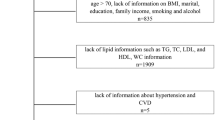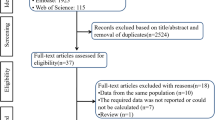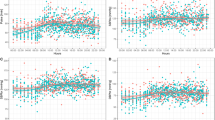Abstract
There is growing evidence of a link between ED, metabolic syndrome (MS) and cardiovascular disease (CVD). The study was to explore the prevalence of MS using three different definitions (World Health Organization (WHO), International Diabetes Foundation (IDF) and Adult Treatment Panel III (ATP III)), and to compare the association of CVD in ED outpatients using these definitions. This study enrolled 254 participants with a mean age of 55.3±0.9 years (range, 21 to 81 years) with ED as diagnosed by International Index of Erectile Function score. All participants underwent MS evaluation based on the three criteria. Differences of MS prevalence, demographical characteristics, biochemical profiles, pro-inflammatory and inflammatory markers, echocardiographic characteristics and the association with Framingham cardiac risk score (FCRS) were compared. The presence of diabetes mellitus (DM) in the WHO group and high waist girth in the IDF group were significant because of the necessity of respective criteria. The MS prevalence in the WHO, IDF and ATP III groups was 30.7, 34.3 and 36.6%, respectively (P=0.367). The degrees of agreement among each definition were substantial to perfect. No significant findings in echocardiographic characteristics, biochemical, inflammatory and pro-inflammatory markers were noted. The FCRS showed borderline nonsignificant difference (17.9±0.4, 16.8±0.4 and 16.9±0.4, P=0.079); however, the FCRS was more closely correlated with the WHO than with the IDF and ATP III (Spearman's correlation coefficients were 0.522, 0.531 and 0.462, respectively; P=0.021). In patients < 55 years of age and those who smoke, the Spearman’s correlation in the WHO group was significantly higher than in the IDF and ATP III groups. The prevalence of the MS using different definitions in ED patients was not different. The WHO-defined MS was more closely associated with CVD.
This is a preview of subscription content, access via your institution
Access options
Subscribe to this journal
Receive 8 print issues and online access
$259.00 per year
only $32.38 per issue
Buy this article
- Purchase on Springer Link
- Instant access to full article PDF
Prices may be subject to local taxes which are calculated during checkout

Similar content being viewed by others
References
Feldman HA, Goldstein I, Hatzichristou DG, Krane RJ, McKinlay JB . Impotence and its medical and psychosocial correlates: results of the Massachusetts Male Aging Study. J Urol 1994; 151: 54–61.
El-Sakka AI, Morsy AM, Fagih BI, Nassar AH . Coronary artery risk factors in patients with erectile dysfunction. J Urol 2004; 172: 251–254.
Feldman HA, Johannes CB, Derby CA, Kleinman KP, Mohr BA, Araujo AB et al. Erectile dysfunction and coronary risk factors: prospective results from the Massachusetts male aging study. Prev Med 2000; 30: 328–338.
Gazzaruso C, Giordanetti S, De Amici E, Bertone G, Falcone C, Geroldi D et al. Relationship between erectile dysfunction and silent myocardial ischemia in apparently uncomplicated type 2 diabetic patients. Circulation 2004; 110: 22–26.
Blumentals WA, Gomez-Caminero A, Joo S, Joo S, Vannappagari V . Should erectile dysfunction be considered as a marker for acute myocardial infarction? Results from a retrospective cohort study. Int J Impot Res 2004; 16: 350–353.
Chang ST, Chu CM, Hsu JT, Hsiao JF, Chung CM, Ho C et al. Independent determinants of coronary artery disease in erectile dysfunction patients. J Sex Med 2010; 7: 1478–1487.
Isomaa B, Almgren P, Tuomi T, Forsen B, Lahti K, Nissen M et al. Cardiovascular morbidity and mortality associated with the metabolic syndrome. Diabetes Care 2001; 24: 683–689.
Mykkanen L, Zaccaro DJ, Wagenknecht LE, Robbins DC, Gabriel M, Haffner SM . Microalbuminuria is associated with insulin resistance in nondiabetic subjects: the insulin resistance atherosclerosis study. Diabetes 1998; 47: 793–800.
Bansal TC, Guay AT, Jacobson J, Woods BO, Nesto RW . Incidence of metabolic syndrome and insulin resistance in a population with organic erectile dysfunction. J Sex Med 2005; 2: 96–103.
Chang ST, Chu CM, Hsu JT, Lin PC, Shee JJ . Surveillance of cardiovascular risk factors for outpatients in different erectile dysfunction severity. Int J Impot Res 2009; 21: 116–121.
Rosen RC, Cappelleri JC, Smith MD, Lipsky J, Pena BM . Development and evaluation of an abridged, 5-item version of the International Index of Erectile Function (IIEF-5) as a diagnostic tool for erectile dysfunction. Int J Impot Res 1999; 11: 319–326.
Bakker AJ . Detection of Microalbuminuria: Receiver operating characteristic curve analysis favors albumin-to-creatinine ratio over albumin concentration. Diabetes Care 1999; 22: 307–313.
Anderson KM, Wilson PW, Odell PM, Kannel WB . An updated coronary risk profile. A statement for health professionals. Circulation 1991; 83: 356–362.
Grundy SM, Brewer Jr HB, Cleeman JI, Smith Jr SC, Lenfant C . American Heart Association; National Heart, Lung, and Blood Institute. Definition of metabolic syndrome: Report of the National Heart, Lung, and Blood Institute/American Heart Association conference on scientific issues related to definition. Circulation 2004; 109: 433–438.
Expert panel on detection, evaluation, and treatment of high blood cholesterol in adults. Executive Summary of The Third Report of The National Cholesterol Education Program (NCEP) Expert Panel on Detection, Evaluation, And Treatment of High Blood Cholesterol In Adults (Adult Treatment Panel III). JAMA 2001; 285: 2486–2497.
Alberti KG, Zimmet P, Shaw J, The ID Epidemiology Task Force Consensus Group. The metabolic syndrome--a new worldwide definition. Lancet 2005; 366: 1059–1062.
Chang ST, Chu CM, Hsu JT, Chung CM, Pan KL, Hsiao JF et al. Scrutiny of cardiovascular risk factors by assessing arterial stiffness in erectile dysfunction patients. World J Urol 2010; 28: 625–630.
Landis JR, Koch GG . The measurement of observer agreement for categorical data. Biometetrics 1977; 33: 159–174.
Chang ST, Chu CM, Hsiao JF, Chung CM, Shee JJ, Chen CS et al. Coronary phenotypes in patients with erectile dysfunction and silent ischemic heart disease: A pilot study. J Sex Med 2010; 7: 2798–2804.
Ma RC, So WY, Yang X, Yu LW, Kong AP, Ko GT et al. Erectile dysfunction predicts coronary heart disease in type 2 diabetes. J Am Coll Cardiol 2008; 51: 2045–2050.
Bal K, Oder M, Sahin AS, Karatas CT, Demir O, Can E et al. Prevalence of metabolic syndrome and its association with erectile dysfunction among urologic patients: metabolic backgrounds of erectile dysfunction. Urology 2007; 69: 356–360.
Esposito K, Giugliano F, Martedi E, Feola G, Marfella R, D’Armiento M et al. High proportions of erectile dysfunction in men with the metabolic syndrome. Diabetes Care 2005; 28: 1201–1203.
Eaton CB, Liu YL, Mittleman MA, Miner M, Glasser DB, Rimm EB . A retrospective study of the relationship between biomarkers of atherosclerosis and erectile dysfunction in 988 men. Int J Impot Res 2007; 19: 218–225.
Vlachopoulos C, Aznaouridis K, Ioakeimidis N, Rokkas K, Vasiliadou C, Alexopoulos N et al. Unfavourable endothelial and inflammatory state in erectile dysfunction patients with or without coronary artery disease. Eur Heart J 2006; 27: 2640–2648.
Azadzoi KM, Goldstein I . Erectile dysfunction due to atherosclerotic vascular disease: the development of an animal model. J Urol 1992; 147: 1675–1681.
Sullivan ME, Thompson CS, Dashwood MR, Khan MA, Jeremy JY, Morgan RJ et al. Nitric oxide and penile erection: is erectile dysfunction another manifestation of vascular disease? Cardiovasc Res 1999; 43: 658–665.
Heidler S, Temml C, Broessner C, Mock K, Rauchenwald M, Madersbacher S et al. Is the metabolic syndrome an independent risk factor for erectile dysfunction? J Urol 200; 177: 651–654.
Athyros VG, Ganotakis ES, Elisaf MS, Liberopoulos EN, Goudevenos IA, Karagiannis A, GREECE-METS Collaborative Group. Prevalence of vascular disease in metabolic syndrome using three proposed definitions. Int J Cardiol 2007; 117: 204–210.
Li WJ, Xue H, Sun K, Song XD, Wang YB, Zhen YS et al. Cardiovascular risk and prevalence of metabolic syndrome by differing criteria. Chin Med J 2008; 121: 1532–1536.
Luk AO, Ma RC, So WY, Yang XL, Kong AP, Ozaki R et al. The NCEP-ATP III but not the IDF criteria for the metabolic syndrome identify type 2 diabetic patients at increased risk of chronic kidney disease. Diabet Med 2008; 25: 1419–1425.
Sone H, Tanaka S, Ishibashi S, Yamasaki Y, Oikawa S, Ito H et al. Japan Diabetes Complications Study (JDCS) Group. The new worldwide definition of metabolic syndrome is not a better diagnostic predictor of cardiovascular disease in Japanese diabetic patients than the existing definitions: additional analysis from the Japan Diabetes Complications Study. Diabetes Care 2006; 29: 145–147.
Milionis HJ, Kostapanos MS, Liberopoulos EN, Goudevenos J, Athyros VG, Mikhailidis DP et al. Different definitions of the metabolic syndrome and risk of first-ever acute ischaemic non-embolic stroke in elderly subjects. Int J Clin Pract 2007; 1: 545–551.
Acknowledgements
We would like to thank Chang Gung Memorial Hospital for financially supporting this research under Contract No. CMRPG680491 Chiayi/Taiwan.
Author information
Authors and Affiliations
Corresponding author
Ethics declarations
Competing interests
The authors declare no conflict of interest.
Rights and permissions
About this article
Cite this article
Chang, ST., Chu, CM., Pan, KL. et al. Prevalence and cardiovascular disease risk differences for erectile dysfunction patients by three metabolic syndrome definitions. Int J Impot Res 23, 87–93 (2011). https://doi.org/10.1038/ijir.2011.9
Received:
Revised:
Accepted:
Published:
Issue Date:
DOI: https://doi.org/10.1038/ijir.2011.9



